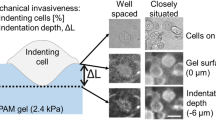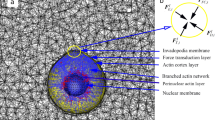Abstract
The biophysical properties of cells change with cancer invasion to fulfill their metastatic behavior. Cell softening induced by cancer is highly associated with alterations in cytoskeleton fibers. Changes in the mechanical properties of cytoskeletal fibers have not been quantified due to technical limitations. In this study, we used the micropipette aspiration technique to calculate and compare the viscoelastic properties of non-invasive and invasive breast cancer cells. We evaluated the mechanical properties of actin fibers and microtubules of two cancerous cell lines by using multiscale tensegrity modeling and an optimization method. Cancer invasion caused altered viscoelastic behavior of cells and the results of modeling showed changes in mechanical properties of major cytoskeleton fibers. The stiffness and viscosity constant of actin fibers in non-invasive cells were 1.28 and 2.27 times higher than those of the invasive cells, respectively. However, changes in mechanical properties of microtubules were minor. Immunofluorescent staining of fibers and their quantified distributions confirmed altered actin distribution among two cell lines, in contrast to microtubule distribution. This study highlights the function of cytoskeletal fibers in cancer progression, which could be of interest in designing therapeutic strategies to target cancer progress.
Graphical abstract

Firstly, the viscoelastic behavior of non-invasive and invasive cells is examined with micropipette aspiration tests. A tensegrity model of cells is developed to mimic the viscoelastic behavior of cells, and tensegrity element stiffness is evaluated in an optimization procedure based on micropipette aspiration tests. Finally, by using immunofluorescent staining and confocal imaging, mechanical properties of actin filaments and microtubules of cancer cells are investigated during the course of metastasis.







Similar content being viewed by others
References
Kraning-Rush CM, Califano JP, Reinhart-King CA (2012) Cellular traction stresses increase with increasing metastatic potential. PLoS One 7(2):e32572
Kassianidou E, Kumar S (2015) A biomechanical perspective on stress fiber structure and function. Biochim Biophys Acta (BBA)-Mol Cell Res 1853(11):3065–3074
Zhang J, Wang C (2014) Molecular structural mechanics model for the mechanical properties of microtubules. Biomech Model Mechanobiol 13(6):1175–1184
Labouesse C, Gabella C, Meister JJ, Vianay B, Verkhovsky AB (2016) Microsurgery-aided in-situ force probing reveals extensibility and viscoelastic properties of individual stress fibers. Sci Rep 6:23722
Katoh K, Kano Y, Masuda M, Onishi H, Fujiwara K (1998) Isolation and contraction of the stress fiber. Mol Biol Cell 9(7):1919–1938
Liu X, Pollack GH (2002) Mechanics of F-actin characterized with microfabricated cantilevers. Biophys J 83(5):2705–2715
Costa KD, Hucker WJ, Yin FC (2002) Buckling of actin stress fibers: a new wrinkle in the cytoskeletal tapestry. Cell Motil Cytoskeleton 52(4):266–274
Kojima H, Ishijima A, Yanagida T (1994) Direct measurement of stiffness of single actin filaments with and without tropomyosin by in vitro nanomanipulation. Proc Natl Acad Sci 91(26):12962–12966
Kishino A, Yanagida T (1988) Force measurements by micromanipulation of a single actin filament by glass needles. Nature 334(6177):74–76
Ebashi S, Ebashi F (1964) A new protein component participating in the superprecipitation of myosin B. J Biochem 55(6):604–613
Weber A, Winicur S (1961) The role of calcium in the superprecipitation of actomyosin. J Biol Chem 236(31):g8–g3202
Spicer SS (1951) Gel formation caused by adenosine triphosphate in actomyosin solutions. J Biol Chem 190(1):257–267
Satcher RL Jr, Dewey CF Jr (1996) Theoretical estimates of mechanical properties of the endothelial cell cytoskeleton. Biophys J 71(1):109–118
Li J, Dao M, Lim CT, Suresh S (2005) Spectrin-level modeling of the cytoskeleton and optical tweezers stretching of the erythrocyte. Biophys J 88(5):3707–3719
Coughlin MF, Stamenovic D (2003) A prestressed cable network model of the adherent cell cytoskeleton. Biophys J 84(2 Pt 1):1328–1336
Ladjal H, Hanus JL, Ferreira A (2013) Micro-to-nano biomechanical modeling for assisted biological cell injection. IEEE Trans Biomed Eng 60(9):2461–2471
Stamenović D, Ingber DE (2002) Models of cytoskeletal mechanics of adherent cells. Biomech Model Mechanobiol 1(1):95–108
Stamenovic D, Coughlin MF (2000) A quantitative model of cellular elasticity based on tensegrity. J Biomech Eng 122(1):39–43
Canadas P et al (2002) A cellular tensegrity model to analyse the structural viscoelasticity of the cytoskeleton. J Theor Biol 218(2):155–173
Pozo-Guisado E, Alvarez-Barrientos A, Mulero-Navarro S, Santiago-Josefat B, Fernandez-Salguero PM (2002) The antiproliferative activity of resveratrol results in apoptosis in MCF-7 but not in MDA-MB-231 human breast cancer cells: cell-specific alteration of the cell cycle. Biochem Pharmacol 64(9):1375–1386
Nematbakhsh Y, Pang KT, Lim CT (2017) Correlating the viscoelasticity of breast cancer cells with their malignancy. Convergent Sci Phys Oncol 3(3):034003
Li QS, Lee GYH, Ong CN, Lim CT (2008) AFM indentation study of breast cancer cells. Biochem Biophys Res Commun 374(4):609–613
Guilak F, Alexopoulos LG, Haider MA, Ting-Beall HP, Setton LA (2005) Zonal uniformity in mechanical properties of the chondrocyte pericellular matrix: micropipette aspiration of canine chondrons isolated by cartilage homogenization. Ann Biomed Eng 33(10):1312–1318
Guilak F, Tedrow JR, Burgkart R (2000) Viscoelastic properties of the cell nucleus. Biochem Biophys Res Commun 269(3):781–786
Theret DP, Levesque MJ, Sato M, Nerem RM, Wheeler LT (1988) The application of a homogeneous half-space model in the analysis of endothelial cell micropipette measurements. J Biomech Eng 110(3):190–199
Hochmuth RM (2000) Micropipette aspiration of living cells. J Biomech 33(1):15–22
Yu H, Tay CY, Leong WS, Tan SCW, Liao K, Tan LP (2010) Mechanical behavior of human mesenchymal stem cells during adipogenic and osteogenic differentiation. Biochem Biophys Res Commun 393(1):150–155
Tan SC, Pan WX, Ma G, Cai N, Leong KW, Liao K (2008) Viscoelastic behaviour of human mesenchymal stem cells. BMC Cell Biol 9(1):40
Nikkhah M, Strobl JS, de Vita R, Agah M (2010) The cytoskeletal organization of breast carcinoma and fibroblast cells inside three dimensional (3-D) isotropic silicon microstructures. Biomaterials 31(16):4552–4561
Stamenović D, Fredberg JJ, Wang N, Butler JP, Ingber DE (1996) A microstructural approach to cytoskeletal mechanics based on tensegrity. J Theor Biol 181(2):125–136
Wendling S, Oddou C, Isabey D (1999) Stiffening response of a cellular tensegrity model. J Theor Biol 196(3):309–325
Mohri F, Motro R (1993) Static and kinematic determination of generalized space reticulated systems. Struct Eng Rev 5(3):231–237
Canadas P et al (2003) Mechanisms governing the visco-elastic responses of living cells assessed by foam and tensegrity models. Med Biol Eng Comput 41(6):733–739
Mofrad MR, Kamm RD (2006) Cytoskeletal mechanics: models and measurements in cell mechanics. Cambridge University Press
Khani MM, Tafazzoli-Shadpour M, Rostami M, Peirovi H, Janmaleki M (2014) Evaluation of mechanical properties of human mesenchymal stem cells during differentiation to smooth muscle cells. Ann Biomed Eng 42(7):1373–1380
Pachenari M, Seyedpour SM, Janmaleki M, Shayan SB, Taranejoo S, Hosseinkhani H (2014) Mechanical properties of cancer cytoskeleton depend on actin filaments to microtubules content: investigating different grades of colon cancer cell lines. J Biomech 47(2):373–379
Mogilner A, Manhart A (2018) Intracellular fluid mechanics: coupling cytoplasmic flow with active cytoskeletal gel. Annu Rev Fluid Mech 50:347–370
Quinlan ME (2016) Cytoplasmic streaming in the Drosophila oocyte. Annu Rev Cell Dev Biol 32:173–195
Gross SR (2013) Actin binding proteins: their ups and downs in metastatic life. Cell Adhes Migr 7(2):199–213
Fletcher DA, Mullins RD (2010) Cell mechanics and the cytoskeleton. Nature 463(7280):485–492
Koch TM, Münster S, Bonakdar N, Butler JP, Fabry B (2012) 3D traction forces in cancer cell invasion. PLoS One 7(3):e33476
Suresh S (2007) Biomechanics and biophysics of cancer cells. Acta Mater 55(12):3989–4014
Kumar S, Weaver VM (2009) Mechanics, malignancy, and metastasis: the force journey of a tumor cell. Cancer Metastasis Rev 28(1–2):113–127
Yilmaz M, Christofori G (2009) EMT, the cytoskeleton, and cancer cell invasion. Cancer Metastasis Rev 28(1–2):15–33
Kemp JP, Brieher WM (2018) The actin filament bundling protein α-actinin-4 actually suppresses actin stress fibers by permitting actin turnover. J Biol Chem 293(37):14520–14533
Zhang R et al (2020) Dynamin regulates the dynamics and mechanical strength of the actin cytoskeleton as a multifilament actin-bundling protein. Nat Cell Biol:1–15
Author information
Authors and Affiliations
Corresponding author
Additional information
Publisher’s note
Springer Nature remains neutral with regard to jurisdictional claims in published maps and institutional affiliations.
Rights and permissions
About this article
Cite this article
Tabatabaei, M., Tafazzoli-Shadpour, M. & Khani, M.M. Altered mechanical properties of actin fibers due to breast cancer invasion: parameter identification based on micropipette aspiration and multiscale tensegrity modeling. Med Biol Eng Comput 59, 547–560 (2021). https://doi.org/10.1007/s11517-021-02318-w
Received:
Accepted:
Published:
Issue Date:
DOI: https://doi.org/10.1007/s11517-021-02318-w




